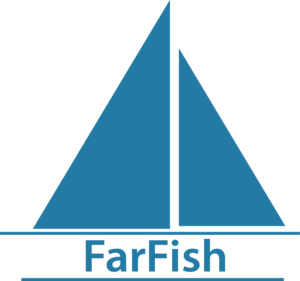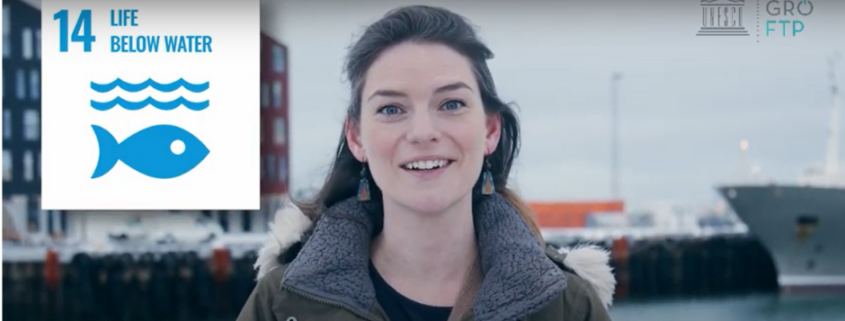UNESCO GRÓ-FTP’s Sustainable Development Goal 14 Video Series
FarFish partners at UNESCO GRÓ Fisheries Training Programme, who lead the project’s work on Capacity Development and Dissemination (WP7) have developed a series of videos unpacking the science and processes behind the United Nations Sustainable Development Goal 14 targets.
This series of videos explores Sustainable Development Goal 14, which relates to life in water and how we can build a path towards conserving living aquatic resources in our oceans and seas.
There are ten targets within SDG 14, and five of them deal with fisheries and how humans can use the living aquatic resources to build the future we want. SDG 14 deals with interactions between humans and aquatic ecosystems. All over the world people rely on these systems to provide them with food, income, livelihoods, and ecosystem services like regulation of the global climate.
For over 20-years the Fisheries Training Program has worked towards building capacity in developing countries to sustainably manage living aquatic resources. Through training and research, the Fisheries Training Programme has worked all over the world, and trained over 400 fisheries professionals, working with research institutions, universities and government agencies in developing countries.
In this SDG 14 video series we explore some of the major issues facing the development of fisheries across the world today.
Small projects for big impact in fisheries; Towards Sustainable Development Goal 14
SDG target 14.4 aims to effectively regulate harvesting, end overfishing, illegal, unreported, and unregulated fishing and to end destructive fishing practices. Essentially, this is about fisheries management. The first step in achieving this target is the creation of governance structures that support sustainable management in fisheries. Having rules in place is one thing, but making it work in practice can be an entirely different challenge. Daði Már Kristófersson is a natural resource economist and a professor at the University of Iceland. In this video, he walks us through some examples of how small incentives can lead to real changes on the ground.
Preserving the value of fish; towards Sustainable Development Goal 14
SDG 14.7 aims, by 2030, to increase the economic benefits to small island developing states, and least developed countries, from sustainable use of marine resources. Worldwide, about 10% of people rely on fisheries as a source of food and income. If properly managed and handled, fish is a renewable source of protein and micronutrients vital for human health and survival, particularly among the very young and pregnant women. Unfortunately, in many places today, the way fish is handled turns what should be a health food, into a health hazard. If we are going to achieve SDG 14.7, and increase economic benefits to the poorest countries from our marine resources, one of the biggest issues to solve is related to post-harvest loss. What happens to a fish from the time it is caught until it reaches the consumer? Margeir Gissurarson is a food scientist who spent his career researching the way fish spoils, and what can be done to preserve it better. In this video, he describes how we can make the most out of these precious marine resources.
Data for sustainable fisheries management; towards Sustainable Development Goal 14
SDG target 14.4 asks us to implement science-based management plans to restore fish stocks to maximum sustainable yield as determined by their biological characteristics in the shortest time feasible. A generation ago, 90% of the fish stocks we harvested came from sustainably sourced stocks, today the number is closer to 66%. To achieve target 14.4 and restore fish stocks to MSY, we need information about those stocks, but how do we know what is going on with the fish stocks we want to harvest? Einar Hjörleifsson is a fisheries biologist with the Marine and Freshwater Research Institute in Iceland. In this video, he talks us through a through a fundamental fisheries equation to help us solve this problem.
Defining and defending small scale fisheries; towards Sustainable Development Goal 14
SDG target 14b aims to provide access for small-scale artisanal fishers to marine resources and markets. The UN FAO estimates that about 2/3 of all fish caught for direct human consumption comes from small scale fisheries. 90% of the people directly employed and dependent on fisheries are in the small-scale sector. But what do we really mean when we use the term “small-scale fisheries”? The definition has changed over time, and may be different, depending on where you live. We tend to think of small-scale fisheries as being rooted in local communities, traditions, and values. We imagine that small-scale fishers are self-employed and usually provide food for their communities and households. Tumi Tómasson is a fisheries biologist who has worked all over the world in fisheries development. In this video, he takes us through the concept of small-scale fisheries, how it has changed over time, and how we can apply it today.




